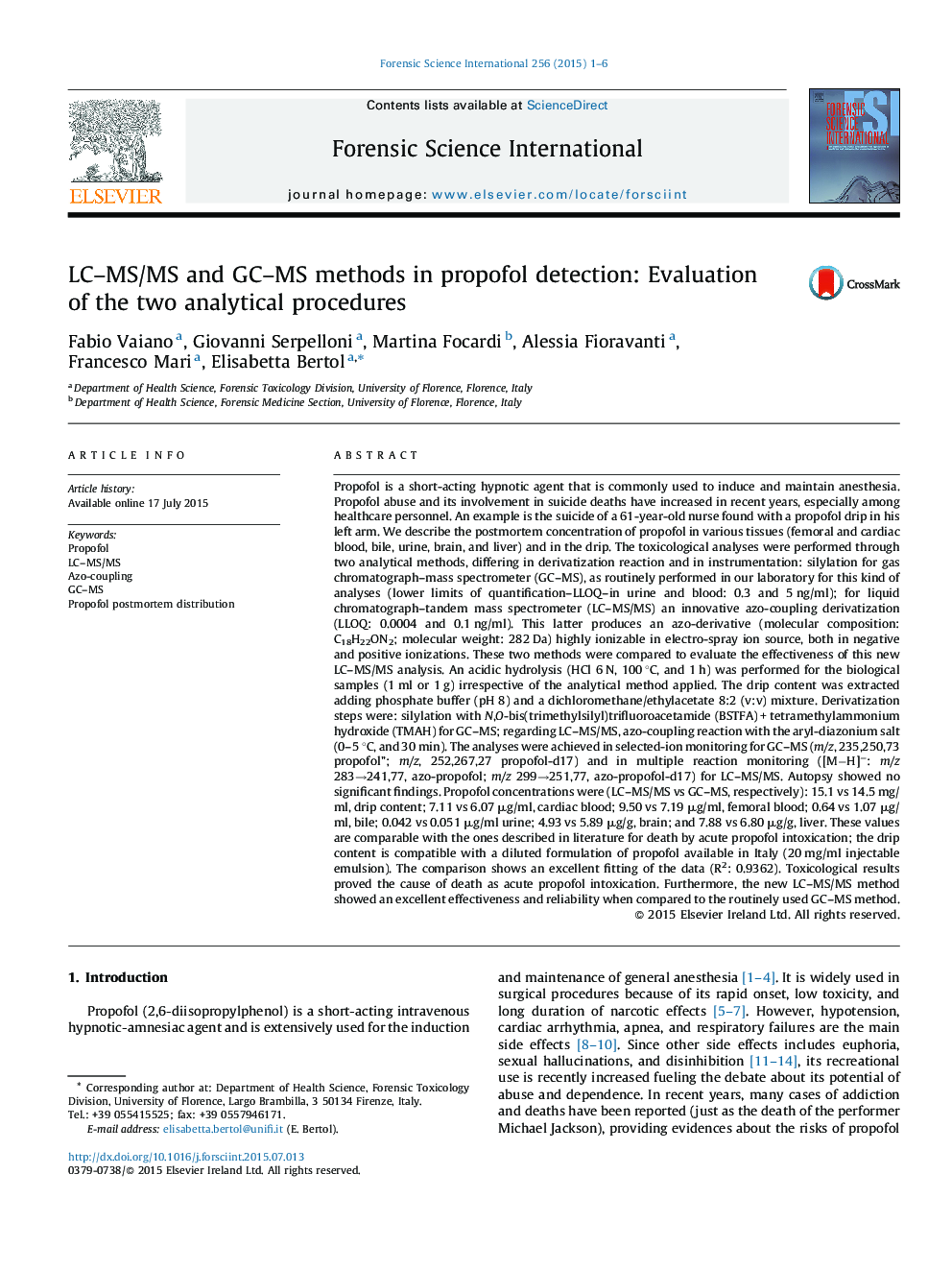| کد مقاله | کد نشریه | سال انتشار | مقاله انگلیسی | نسخه تمام متن |
|---|---|---|---|---|
| 95242 | 160422 | 2015 | 6 صفحه PDF | دانلود رایگان |
• Two methods (GC–MS and LC–MS/MS) were compared in a death case by propofol.
• No statistically significant difference was observed among the results.
• A longer time consuming of azo-coupling was balanced by a faster analytical run.
• Azo-coupling proved to be effective and reliable as derivatization reaction.
• Toxicological findings prove the cause of death as acute propofol intoxication.
Propofol is a short-acting hypnotic agent that is commonly used to induce and maintain anesthesia. Propofol abuse and its involvement in suicide deaths have increased in recent years, especially among healthcare personnel. An example is the suicide of a 61-year-old nurse found with a propofol drip in his left arm. We describe the postmortem concentration of propofol in various tissues (femoral and cardiac blood, bile, urine, brain, and liver) and in the drip. The toxicological analyses were performed through two analytical methods, differing in derivatization reaction and in instrumentation: silylation for gas chromatograph–mass spectrometer (GC–MS), as routinely performed in our laboratory for this kind of analyses (lower limits of quantification–LLOQ–in urine and blood: 0.3 and 5 ng/ml); for liquid chromatograph–tandem mass spectrometer (LC–MS/MS) an innovative azo-coupling derivatization (LLOQ: 0.0004 and 0.1 ng/ml). This latter produces an azo-derivative (molecular composition: C18H22ON2; molecular weight: 282 Da) highly ionizable in electro-spray ion source, both in negative and positive ionizations. These two methods were compared to evaluate the effectiveness of this new LC–MS/MS analysis. An acidic hydrolysis (HCl 6 N, 100 °C, and 1 h) was performed for the biological samples (1 ml or 1 g) irrespective of the analytical method applied. The drip content was extracted adding phosphate buffer (pH 8) and a dichloromethane/ethylacetate 8:2 (v:v) mixture. Derivatization steps were: silylation with N,O-bis(trimethylsilyl)trifluoroacetamide (BSTFA) + tetramethylammonium hydroxide (TMAH) for GC–MS; regarding LC–MS/MS, azo-coupling reaction with the aryl-diazonium salt (0–5 °C, and 30 min). The analyses were achieved in selected-ion monitoring for GC–MS (m/z, 235,250,73 propofol”; m/z, 252,267,27 propofol-d17) and in multiple reaction monitoring ([M−H]−: m/z 283→241,77, azo-propofol; m/z 299→251,77, azo-propofol-d17) for LC–MS/MS. Autopsy showed no significant findings. Propofol concentrations were (LC–MS/MS vs GC–MS, respectively): 15.1 vs 14.5 mg/ml, drip content; 7.11 vs 6.07 μg/ml, cardiac blood; 9.50 vs 7.19 μg/ml, femoral blood; 0.64 vs 1.07 μg/ml, bile; 0.042 vs 0.051 μg/ml urine; 4.93 vs 5.89 μg/g, brain; and 7.88 vs 6.80 μg/g, liver. These values are comparable with the ones described in literature for death by acute propofol intoxication; the drip content is compatible with a diluted formulation of propofol available in Italy (20 mg/ml injectable emulsion). The comparison shows an excellent fitting of the data (R2: 0.9362). Toxicological results proved the cause of death as acute propofol intoxication. Furthermore, the new LC–MS/MS method showed an excellent effectiveness and reliability when compared to the routinely used GC–MS method.
Figure optionsDownload high-quality image (89 K)Download as PowerPoint slide
Journal: Forensic Science International - Volume 256, November 2015, Pages 1–6
